This is a free fortnightly newsletter about the New Zealand Net. If you would like to be notified by email when a new edition is published, please contact ZL1NZ.
Browse our Newsletter Archive and List of Net Tips.
Featured key
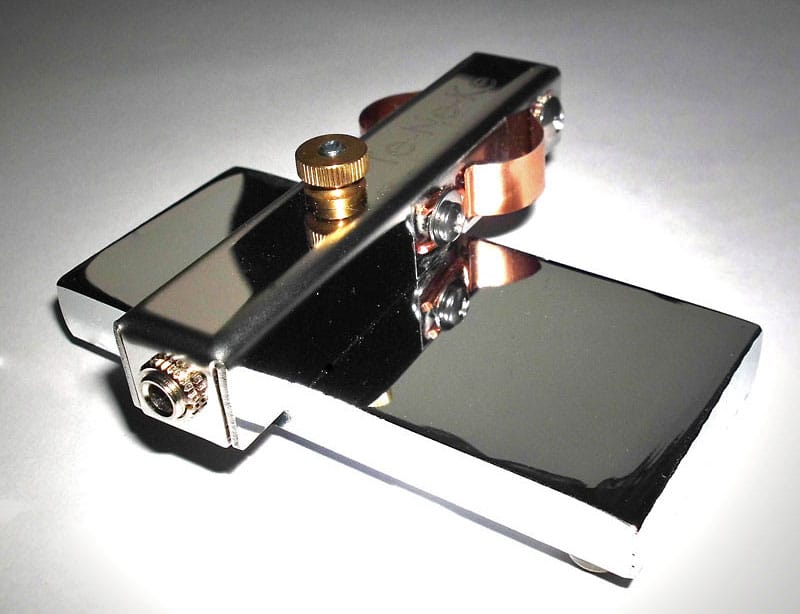
Te-Ne-Ke portable paddles. Photos: DL9GDB
The Te-Ne-Ke (“teeny key”) is a simple but clever design that works like a dual-lever key, despite having no levers. When either of the two beryllium copper springs is squeezed, it makes contact with a brass pin. All parts are mounted on a stainless steel head.
 The key was designed and patented by Boyd Mason NE8KE, whose callsign is reflected in the key’s name.
The key was designed and patented by Boyd Mason NE8KE, whose callsign is reflected in the key’s name.
Two variations of the Te-Ne-Ke exist. The head used to be made from CNC-machined aluminium channel stock with a plastic jewel on the front. Current production units are made from laser-cut stainless steel, without the jewel.
Several users have found the key to be excellent for portable operations. Here’s a good video showing how it works.
The Te-Ne-Ke is built in Michigan, USA by members of the North Ottawa Amateur Radio Club and sells for US$65. The swiveling base is sold separately, or you can make your own.
* If you have an interesting key for this feature, please send me a nice clear photo and a few words describing it.
Quick notes
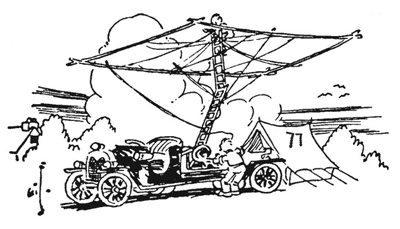
That huge signal heard on 40m during last weekend’s Jock White Field Days has everyone talking. NZ Net News has obtained this secret technical drawing of the aerial responsible for that rock-crusher signal. But will it be enough to secure another top score in the JWFD? We await the official results.
Peter ZL1PJH got Branch 10 back onto CW during Field Days, making 40 CW contacts for ZL1SA, a station which hasn’t been heard on this mode for many years. Peter is currently busy doing the CW Academy training.
Paraset spy radios from WW2 are the topic for an online presentation next week, sponsored by the Radio Security Service Memorial ARS in the UK. The presentation is at 2000 hours Tuesday 8 March UTC (9am Wednesday in New Zealand). Here are the Zoom meeting details in Morse (to avoid letting spammers pick up the details from plain text).
Russia’s war against Ukraine, launched this past week, is heartbreaking and terrifying. A couple of radio-related things I’ve noticed:
- The BBC is ramping up services to Ukraine using shortwave – proving that radio has the ability to reach people when internet services go down.
- Elon Musk was quick to announce that he was providing some of his Starlink terminals to Ukraine, providing satellite-based internet. Then it was pointed out that the radio signals from an earth station would enable the Russians to target Ukrainians with deadly accuracy. Radio isn’t always a good idea.
Cartoon: Gildersleeve in QST, July 1949
Photo flashback

Operators at Slidell Radio WNU. Date unknown. Receivers shown include National HRO-500, JRC (model unknown) and Drake R4B. Courtesy David Ring N1EA
By David Ring Jr N1EA
Slidell Radio WNU was a ship-to-shore station originally founded on the banks of the Mississippi River in New Orleans. The transmitters were at Slidell and the receiver site was in Pearl River, on Radio Road. Later the transmitting facilities were moved to Pearl River.
WNU was originally part of the United Fruit Company’s (UFC) network of radiotelegraph stations.
For more on WNU, have a listen to this edition’s Audio Challenge.
Net numbers
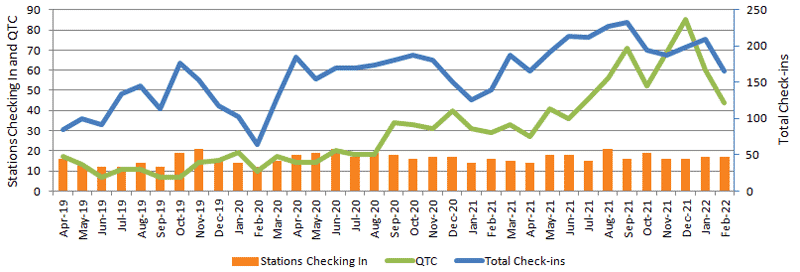
There were 165 check-ins to the NZ Net during February and 44 pieces of traffic handled. These numbers were well above February 2021. Here’s the monthly net report, as transmitted on 1 March:
NR8 R ZL1NZ 43/40 AUCKLAND 0800Z 1MAR22
=
NZ NET
=
FEB QNI VK3DRQ 16 VK4PN 3 ZL1AJY 2 ZL1ANY 18
ZL1BWG 19 ZL1NZ 20 ZL1PC 1 ZL1RD 2 ZL2GD 10
ZL2GVA 20 ZL2KE 13 ZL2LN 4 ZL2WT 3 ZL3TK 20
ZL4CU 6 ZL4FZ 1 ZL4KX 7 TOTAL 165 QTC 44
=
ZL1NZ
Tips & tools: Autek QF-1A audio filter
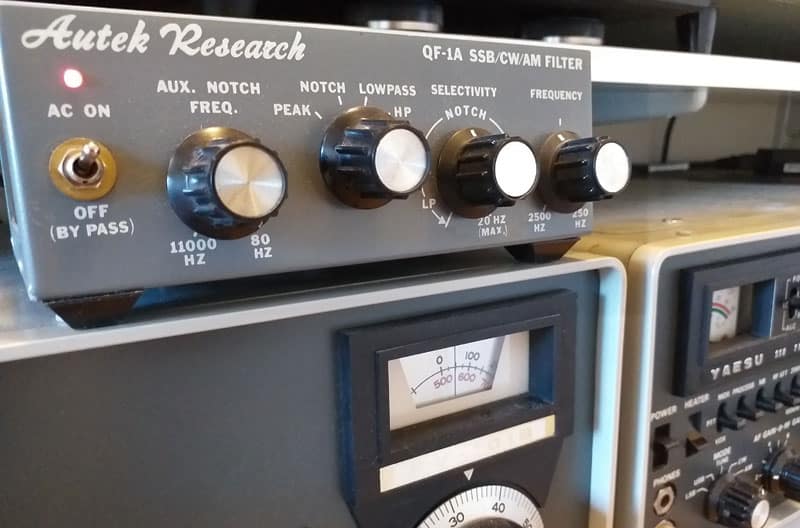
Photo: ZL1NZ
By Neil ZL1NZ
There’s one item in my shack that is second only in importance to my favourite key. It’s my Autek Research QF-1A active audio filter.
These items were sold from the late 1970s into the early 1990s, and were very popular.
A few years ago, I spotted the remains of one at a junk sale in Auckland. The knobs were missing, as was the power switch, all the rear panel connectors and the top of the case. I figured that if somebody had stripped so many items, it probably meant the filter didn’t work. But, for $5 I could not resist.
Fortunately, my junk box included all the missing parts – except the cabinet – right down to the Yaesu-style knobs used by Autek.
When I had finished replacing the missing pieces I turned it on and … it worked perfectly. Probably the best $5 I have ever spent.
Even though my FT-101E has a 500Hz CW filter, the QF-1A made signals jump out of the noise. At first, I tended to use the peak filter, but now I prefer the Low-Pass which seems to give a little smoother tone. There are also High-Pass and Notch filters, plus an Auxilliary Notch. As you can see from the photo, there are lots of adjustments to play with, but once set to my liking, I rarely touch them.
I have now upgraded to an FT-101ZD which, sadly, does not have a CW filter, but the old Autek makes it a respectable CW rig. Here in central Auckland, I typically have noise levels on 80m between S6 and S8. Many signals on the NZ Net are S6, but the filter really helps with the copy.
The QF-1A has really stood the test of time, and gets top marks from fone ops too. I have tried a couple of outboard DSP boxes and, in my opinion, the QF-1A does a better job and is nicer to listen to.
Got a favourite gadget or technique to make your CW operating easier or more efficient?
Please send a short article and photo to be featured in NZ Net News!
Audio challenge
If you’ve been reading carefully, you’ll already know which station will be featured in this recording.
The station is in the process of sending a traffic list – but for some of the ships on the list the traffic will be sent to them in a mode other than Morse. What mode is it?
Send your answer in a radiogram to ZL1NZ. Audio courtesy David Ring N1EA.
Answer to previous Audio Challenge:
1. The station was 3DP Suva Radio (featured in a recent Photo Flashback).
2. XXX XXX XXX is the urgency signal (the recording included reference to a SAR message).
Correct answers were received from G4ETQ, VK3DRQ, ZL1ANY, ZL1BBW, ZL2GVA, ZL3TK and ZL4KL.
Field Days demand stamina
Contest station ZL1XH enjoys an unbeaten record in the Jock White Field Days, having won the Montgomery Cup plus the national top score on every attempt. This year, however, the team found themselves competing short-handed. There were three operators, but only one could do CW. Cutting back to single-band operation would have been the easy solution, but that’s not how this group rolls. Team leader (and NZ Net member) Paul ZL1AJY stepped into the breach, handling all the CW operating on 80m and 40m for the entire weekend, dashing back and forth between the two operating tents. Now that he’s recovered somewhat, Paul describes how it went…
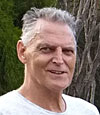 A quick study of the 2021 logs was done to get some idea of average contacts over the 18-hour contest period. It appeared most CW contacts occurred in the first 15 minutes of mode change from fone to CW, usually around 30 minutes past each hour.
A quick study of the 2021 logs was done to get some idea of average contacts over the 18-hour contest period. It appeared most CW contacts occurred in the first 15 minutes of mode change from fone to CW, usually around 30 minutes past each hour.
Using this formula, a fone-to-CW swap on 80m lasted from :30 to :45 past the hour rather than a full half-hour. This was followed by 15 minutes of CW on 40m, from :45 to :00. The rule was fairly relaxed, depending on band conditions.
Both the 80m and 40m stations used Elecraft K3 transceivers with very similar narrow CW filters, full QSK and common RX/TX settings. This greatly simplified swapping bands, the only slightly awkward procedure was plugging my own headset into ear phone audio sockets. Unlike the other ops, I prefer open style phones which don’t enclose the ears.
I key left-handed Iambic, which frees my right hand for logging and transceiver duty. This generally works well but does use up more operating table area. The keys were a Bencher on 80m and magnetic Begali on 40m. These keys have a completely different feel, and I noticed this especially later in the night with sagging enthusiasm and tired eyes! The gentle soft touch Bencher, normally a speedy easy key, became messy and touchy as concentration waned – in contrast to the magnetic Begali with its more positive feel.
Overall our raw CW numbers are likely to be lower than previous years (when we had a CW operator for each band). The multipliers will determine if a single CW operator station can be competitive.
Video: Last telegraph operator in western Canada
This report is from the mid 1970s.
You can still send a telegram in Canada. It just doesn’t involve Morse Code.
Advertising archive

QST magazine, April 1952
Ham radio ads of the 1950s and 1960s had two essentials: an OM wearing a suit and a Vibroplex on the desk. 🙂
Suggestions?
If you have suggestions on how to make the NZ Net better, or things you’d like to see covered in these updates, please contact ZL1NZ. You might even like to write something for the newsletter.
Thanks for reading, and I hope to hear you soon on the NZ Net!
—
Neil Sanderson ZL1NZ, Net Manager
New Zealand Net (NZ NET)
3535.0 kHz at 9pm NZT Mon-Fri

%20Dark%20Logo%20BIG%20TM.png)
